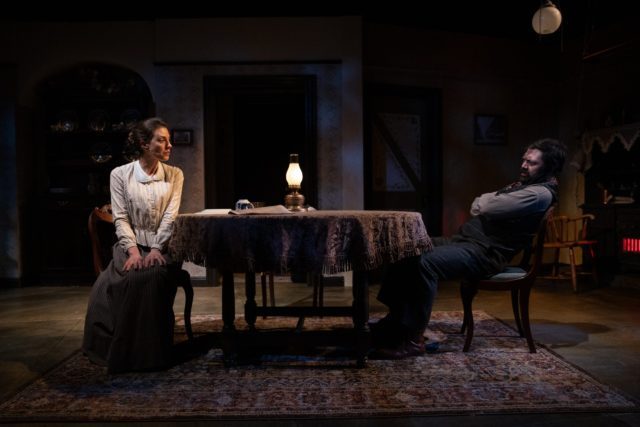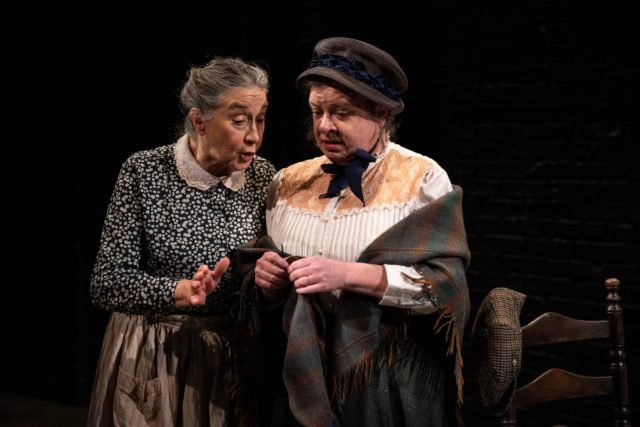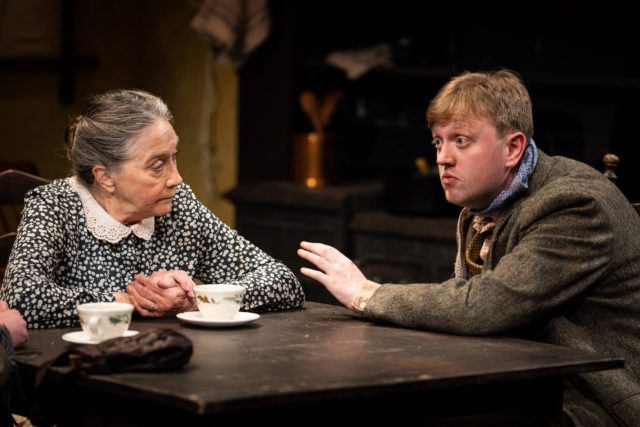
The strained marriage between Minnie Hetherington (Amy Blackman) and Luther Gascoyne (Tom Coiner) is at center of D. H. Lawrence tale (photo by Maria Baranova)
THE DAUGHTER-IN-LAW
New York City Center Stage II
131 West 55th St. between Sixth & Seventh Aves.
Tuesday – Sunday through March 20, $35 – $80
minttheater.org
www.nycitycenter.org
D. H. Lawrence was best known for such novels as Sons and Lovers, Women in Love, and Lady Chatterley’s Lover, but he was also a poet, a painter, and a playwright. The Mint, which specializes in resurrecting long-forgotten, seldom-performed works, returns to the postlockdown stage with a revival of its 2003 adaptation of Lawrence’s 1913 drama, The Daughter-in-Law, which opened tonight at New York City Center Stage II, where it runs through March 20.
The two-act, two-and-a-half-hour show is part of the Nottingham-born Lawrence’s Eastwood Trilogy, which also includes 1909’s A Collier’s Friday Night and 1911’s The Widowing of Mrs. Holroyd. Collier’s and The Daughter-in-Law were not performed in his lifetime; Lawrence died in France in 1930 at the age of forty-four.
Most of the play is a gossipy delight. It takes place during the Great Unrest, as a strike threatens to close down a coal mine in Eastwood (Lawrence’s hometown in Nottingham). Joe Gascoyne (Ciaran Bowling) has broken his arm at the mine fooling around — there’ll be no disability pay for him. He lives with his mother, the domineering Mrs. Gascoyne (Sandra Shipley), who is no fan of marriage, instead preferring to have her boys around her. “Marriage is like a mouse trap, for either man or woman — you’ve soon come ter th’ end o’ th’ cheese,” she tells Joe, who responds, “Well, ha’ef a loaf’s better’nor no bread.” To which his mother advises, “Why, wheer’s th’ loaf as tha’d like ter gnawg a’ thy life.”

Mrs. Gascoyne (Sandra Shipley) and Mrs. Purdy (Polly McKie) have some unpleasantries to discuss in The Daughter-in-Law (photo by Maria Baranova)
Prim and proper Mrs. Purdy (Polly McKie) stops by the Gascoynes, where she beats around the bush before announcing that Mrs. Gascoyne’s oldest son, Luther (Tom Coiner), has impregnated her daughter, Bertha. An engaging conversation ensues, with the upshot being that Mrs. Purdy will get a payoff to save everyone’s reputation and preserve Luther’s weeks-old marriage to Minnie Hetherington (Amy Blackman). Minnie has what is considered a small fortune, acquired from a deceased uncle, and the Gascoynes believe she will have no choice but to cough up the cash for them.
The brutish Luther, covered in dirt and grime from the mine, comes home to Minnie, who likes pretty things and wants everything in its place, from the table and chairs to the silverware and fancy dishes. She has settled for Luther because no one else asked for her hand; she tells her husband, “You’ll be a dayman at seven shillings a day till the end of your life — and you’ll be satisfied, so long as you can shilly-shally through. That’s what your mother did for you — mardin’ you up till you were all mard-soft.” Luther replies, “Tha’s got a lot ter say a’ of a suddin. Thee shut thy mouth.” Minnie: “You’ve been dragged round at your mother’s apron-strings, all the lot of you, till there isn’t half a man among you.” Luther: “Tha seems fond enough of our Joe.” Minnie: “He is th’ best in the bunch.” Luther: “Tha should ha’ married him then.” Clearly, their union is not all sunshine and roses.
Over the course of two weeks, the Gascoynes bicker among themselves as they assume that Minnie will just pay the money and all will be well, with Joe, Luther, and their mother refusing to take responsibility for any of their actions while Minnie recalculates her future. It all leads to a ridiculously overblown, unbelievable, sentimental finale that turns the tables on just about everything that led up to it.

Joe (Ciaran Bowling) explains his situation to this mother (Sandra Shipley) in Mint revival of Lawrence play (photo by Maria Baranova)
Directed again by Martin Platt (The Power of Darkness, A Bold Stroke for a Wife), the production is pristine, a staple of the Mint. Bill Clarke’s set changes neatly from Mrs. Gascoyne’s rickety kitchen and dining room to Minnie’s far more presentable home. Holly Poe Durbin’s period costumes set the mood, along with Jeff Nellis’s soft lighting and Lindsay Jones’s sharp sound design. The play, performed with one intermission, is told primarily in the Ilson dialect, featuring such words as “blackleg,” “butty,” “clunch,” “wringer,” “mard,” “morm,” and “wallit”; it’s worth checking out the glossary in the program in advance.
The Daughter-in-Law often crackles, with a fine cast led by Blackman portraying a kind of early working-class feminist. The story is not complicated, nor is it clichéd; Lawrence told his editor, “It is neither a comedy nor a tragedy — just ordinary.” While the play is not autobiographical, Lawrence’s father was a miner, and his mother died of cancer in 1910; in 1912, he eloped with a married woman who had three children. Thus, the relationships of a son with his mother and lover are an interesting side note while not being definitive. And then comes the ending, which will have you feeling icky as you leave the theater, covered in dirt and grime that you won’t be able to easily wash off.